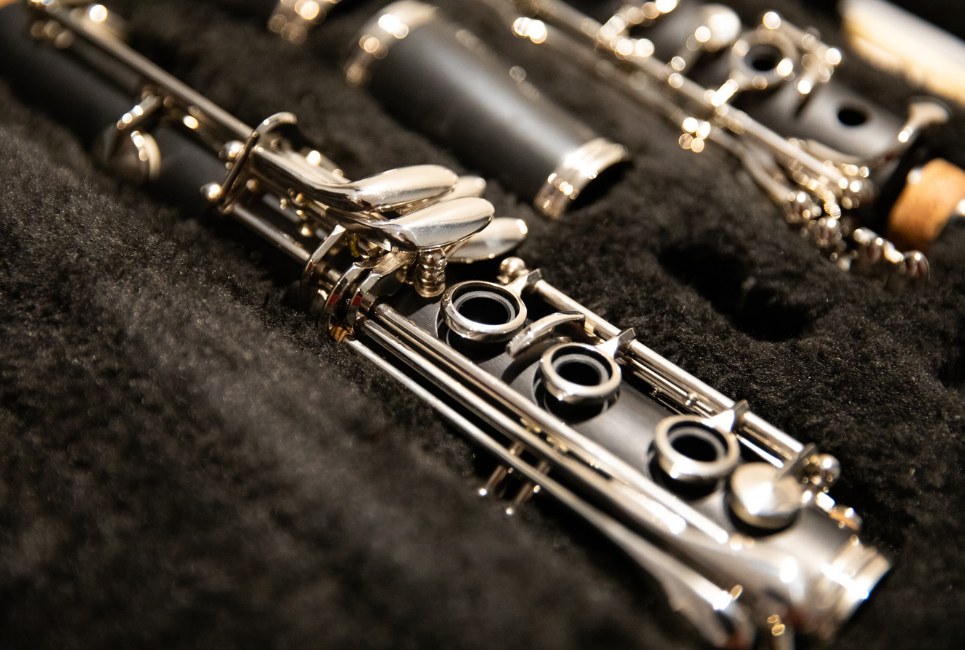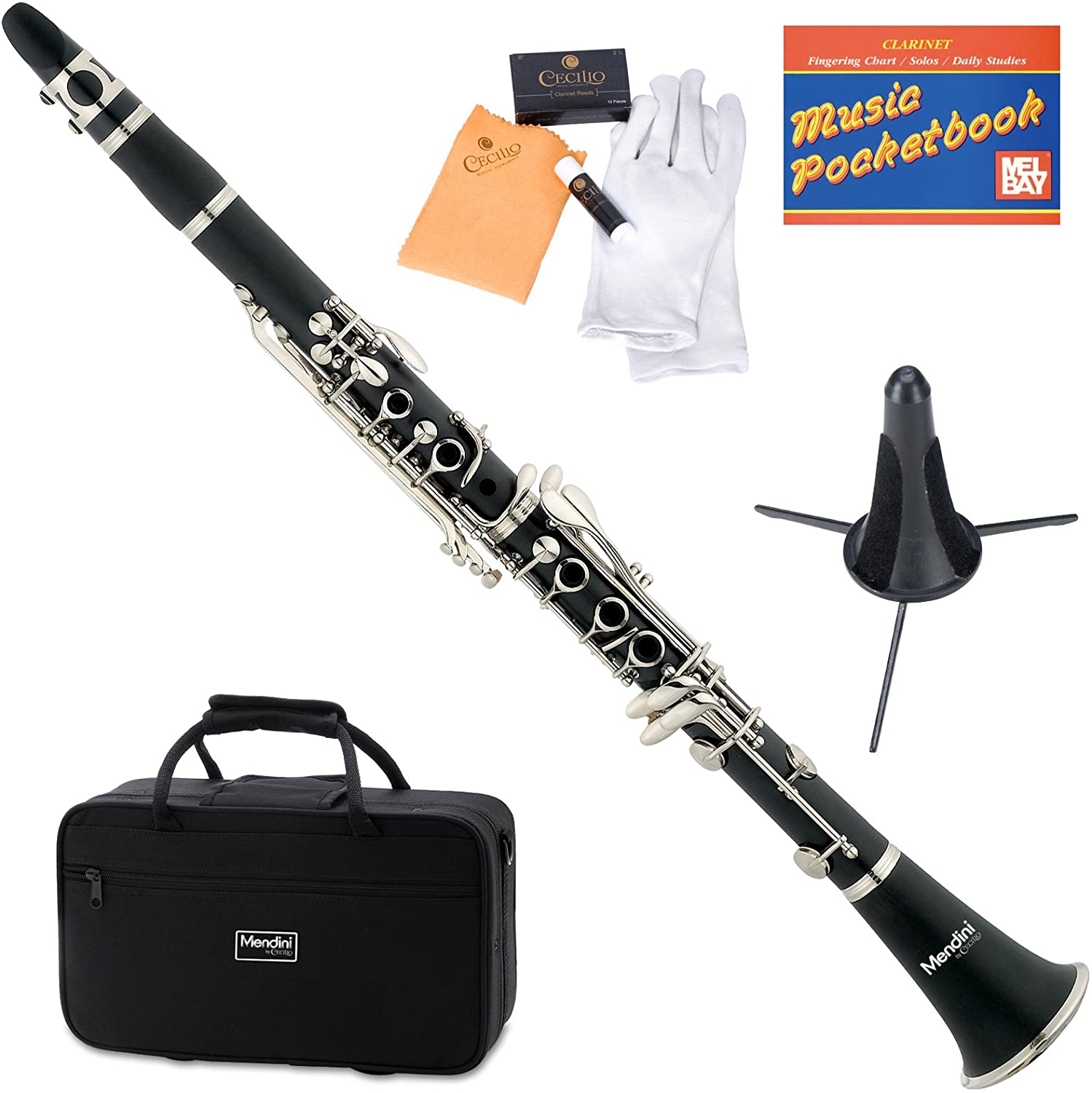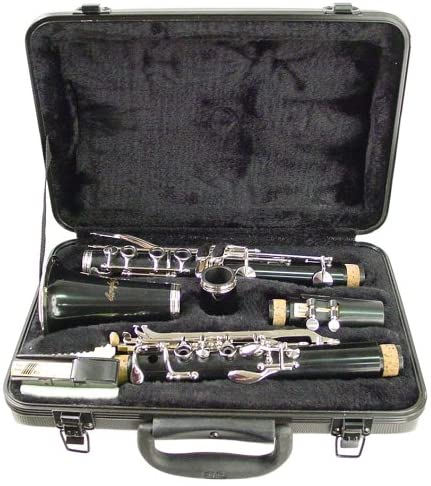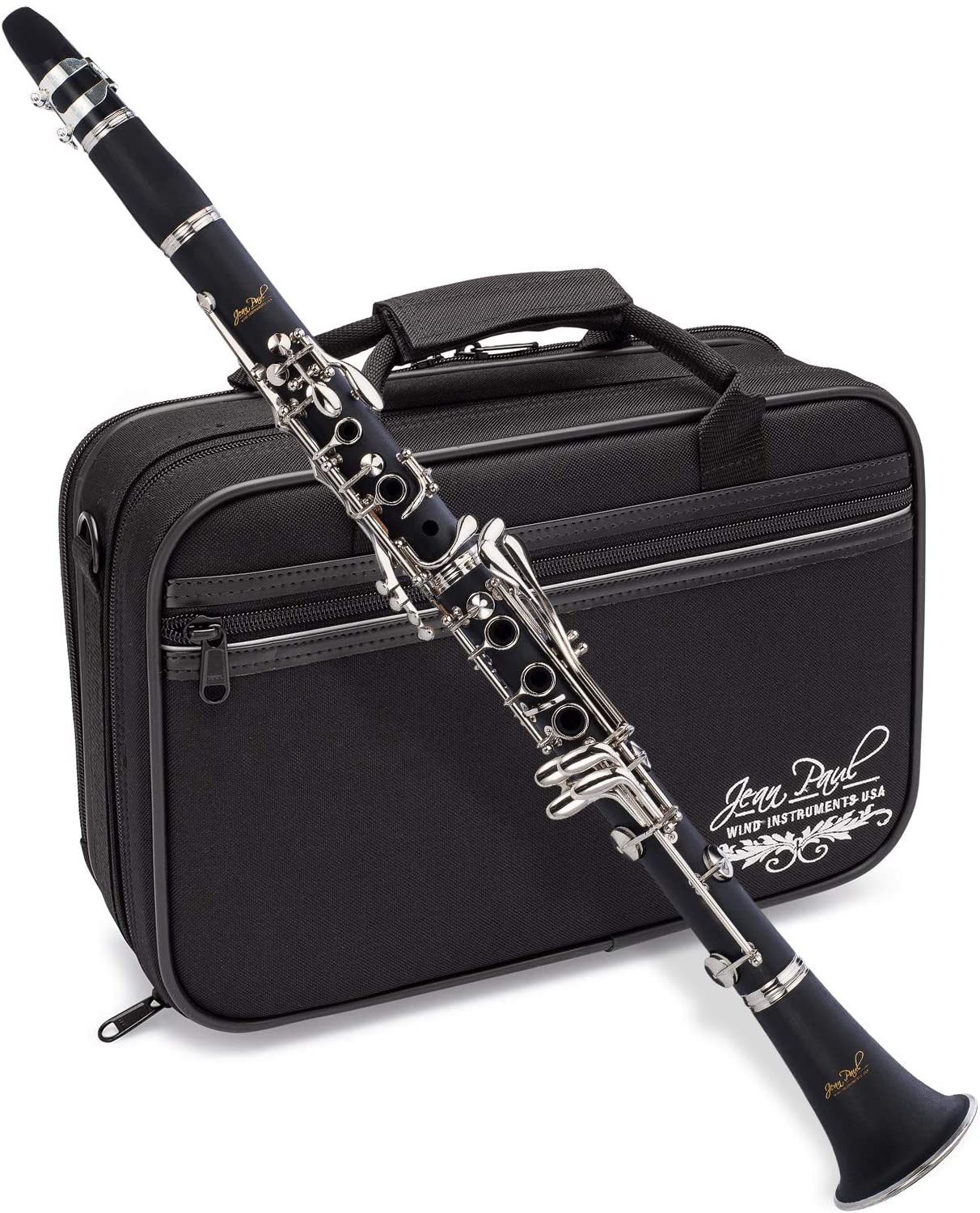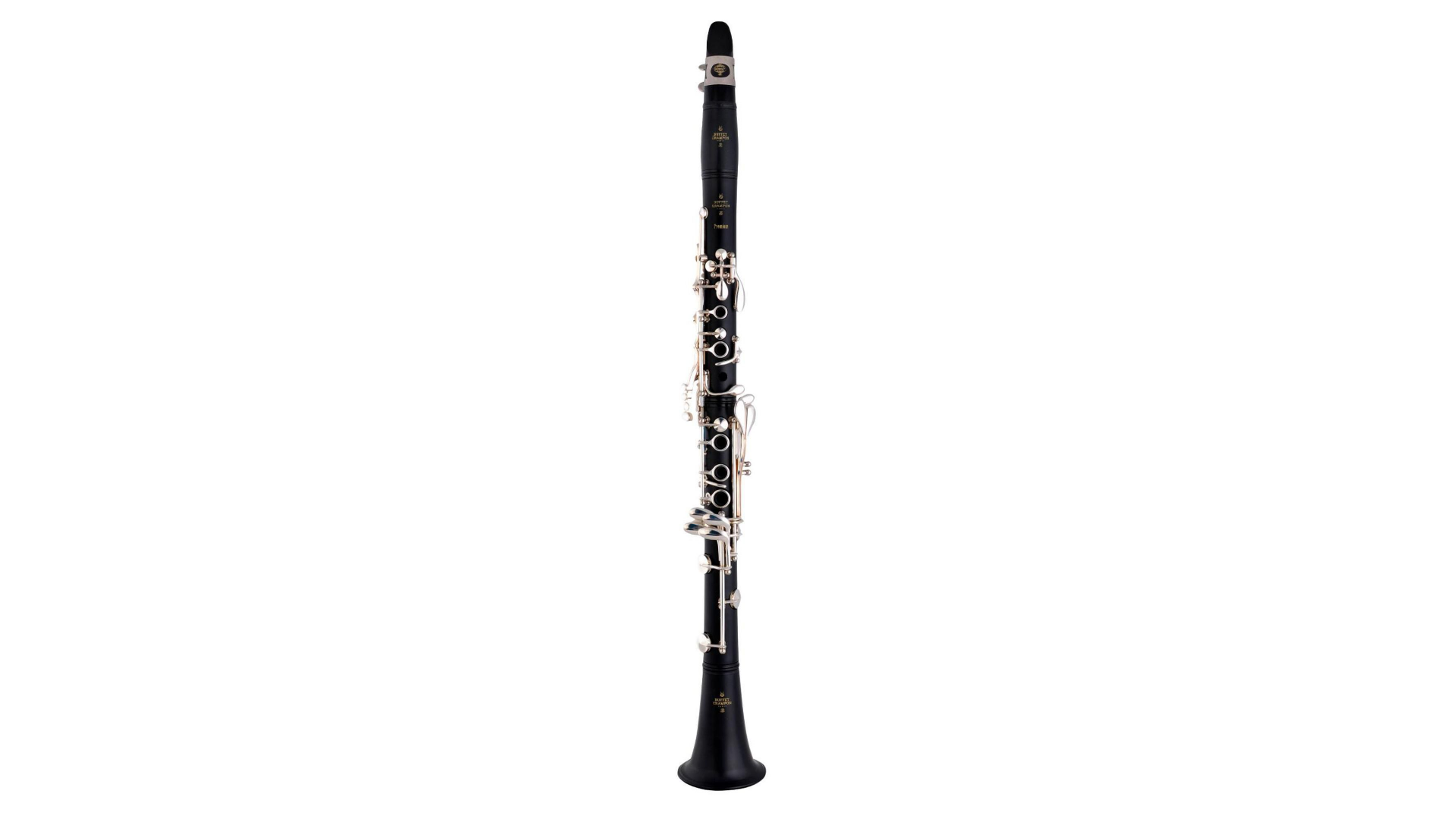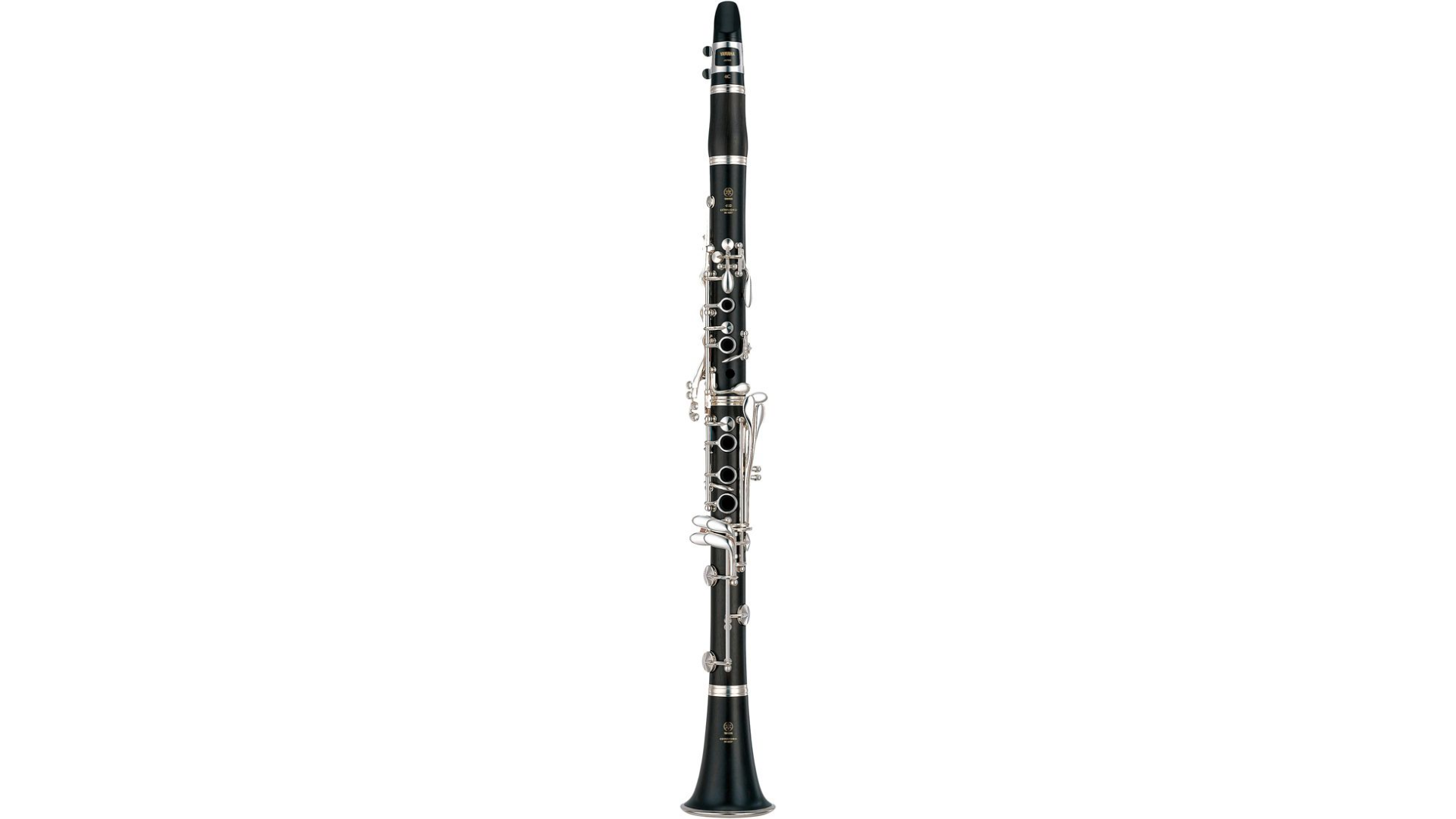- Mendini MV300: An Honest Breakdown and Review - April 6, 2022
- Cecilio Viola Review and Guide: 3 Violas, Which is the Best? - January 21, 2022
- Cecilio Electric Violin Review and Guide: A Silent Practice Violin! - January 20, 2022
Playing an instrument is an excellent investment in your happiness. The clarinet is a versatile woodwind instrument capable of a jazzy solo or blending in with an orchestra. There are many things to consider when purchasing a new clarinet. Still, for a student, the most important is the overall build. Does the clarinet leak, is the material quality, is it a reasonable price for the features, and how long will this last in my music career?
So does the Mendini B Flat Clarinet pass the test, in some ways but not in others! Let’s find out why!
Mendini B Flat Clarinet Pros and Cons
Pros
- Inexpensive
- Plastic Body
- Comes in fun colors
- Comes with an instrument stand
- Adjustable thumb rest
Cons
- Quality control issues
- New mouthpiece and reeds needed right away.
- Will only last a student a year or two.
- No mention of pad type
- Hard to play on and achieve a quality sound
All about Mendini by Cecilio
Mendini is a child company to Cecilio, a known maker of student-level instruments. Their instruments are made in China, but they claim to playtest them in their Los Angeles warehouse. Both Mendini and Cecilio are widely known for their entry-level violins, with product lines that suit advanced-level players.
At one time, they even marketed professional-level violins that turned a few heads, both good and bad. Their products don’t stop with clarinets and strings; Cecilio and Mendini offer various woodwind, brass, and percussion instruments. However, over the last 3 years, both the Mendini and Cecilio lines have slimmed their offerings. They no longer offer many advanced-level instruments, including their Rosewood Clarinet.
The Mendini brand of instruments focuses closely on entry-level to advancing instruments. These instruments are geared toward those who have rented an instrument for an awhile or are just testing the waters. Due to this, these instruments are generally made out of poor-quality materials.
They aren’t capable of growing with their student, and their factory and machine-adjusted construction method can also cause product inconsistencies. Despite the downsides to purchasing their instruments, they have continued to grow in popularity due to availability and low price. They are currently one of the top sellers of student-level Chinese-made instruments.
Vetting a Clarinet Online
When I was young, the only way of acquiring an instrument was to pay a visit to your local music store and hope they carried what you were looking for. This had several benefits, as I could test the instruments I was interested in and make sure they were in working order.
Now you can purchase instruments of all sorts online. This has led to a few problems, it’s easier to scam people inferior or broken instruments, and the market has been overrun with cheap Chinese branded or unbranded instruments. On the other hand, you can now find professional level and quality instruments online like the Buffet R13 Professional Clarinet.
With instruments being widely available on sites like Amazon, more and more people of all ages have access to the joy of playing an instrument. In these ways, the pros of cheaper quality instruments outweigh the cons, as not everyone wants to be a professional musician when they pick up their first clarinet.
What is a Quality Student Clarinet
- Brand: Some instruments’ brand doesn’t matter, but brand means a great deal when it comes to woodwinds and brass instruments. The top brands for student instruments are Selmer, Yamaha, Jupiter, and Jean Paul. I’m partial to Selmer as that is what I grew up on, but other brands like Jean Paul have created quality contenders on the market for less money. Many people purchase brand new instruments over buying old ones because clarinets don’t get better with age. Instead, components will give out and need replacing. There is no benefit in purchasing a used clarinet outside of saving money or getting a model that is out of production.
- Bore Construction: One of the most important aspects of a quality clarinet is how well its made and how well it seals. Student clarinets are typically made out of ABS plastic. Still, ebonite clarinets have become a popular choice for budget models over the years. Ebonite is a synthetic wood engineered to replicate ebony wood used in various instruments. At one time, I picked up an ebonite clarinet from a pawn shop to play with. I found the material to be heavier and the tone a bit duller than a plastic clarinet. I recommend looking for a plastic clarinet from a reputable brand, such as Yamaha, Jean Paul, Selmer, or Jupiter. To ensure that you receive the highest quality construction for your money.
- Seal: The seal of a clarinet is another important aspect of a clarinet. If a clarinet is leaky, it won’t play well, and students will have a hard time acquiring a strong, consistent tone. This is especially true as students advance to play higher registers. Unfortunately, testing the seal of a clarinet can not be done online. A skilled instrument repair person would be able to test, diagnose and fix the cause of clarinet leaking, provided the joints and the clarinet’s keys are in working order.
- Keys & Pads: The keys on student clarinets are typically nickel and plated in nickel because they’re durable and cheap. When looking at a clarinet, the keys need to be in the correct spots, cover the tones holes perfectly when pressed, and fully allow air to flow through the instrument when tone holes are open. The keys should glide quickly into place. Keys that don’t close all the way are a common cause of seal issues in a clarinet. The pads are equally as important as they ensure a tight seal. Most student clarinets have fish skin pads, but cork or even silicone is popular. Leather is the most preferred pad material. An adjustable thumb rest with a neck strap is also ideal.
- Mouthpiece & Barrell: The clarinets often come with two barrels on cheap Chinese-made instruments. This is to compensate for potential tune issues of the clarinet. The mouthpiece is something that you will find a preference for as you grow as a musician. Most musicians have a mouthpiece that they prefer and will continue to use it from instrument to instrument. You will want to purchase a new mouthpiece for cheaper clarinets; a better mouthpiece will help you get a better sound out of the clarinet. I recommend Rico or Vanderhoen mouthpieces.
Mendini B Flat Clarinet Review
The Mendini clarinet is a good starter clarinet. Still, you can acquire a student clarinet that will last you much longer than this one for a little bit more money. This clarinet retails for under 150 dollars currently, which is a steal. If you are just looking to test out an instrument, then this clarinet will suffice. Still, serious students will find themselves quickly disappointed.
- Construction: This clarinet is made out of high-grade plastic, which I will assume is ABS plastic. This was a pleasant surprise for me because I expected the clarinet to be made out of ebonite. This clarinet comes in multiple colors. I’ve seen yellow and red, but they currently offer the clarinet in blue, pink, and black. The black looks very sleek and traditional, while the pink and blue offer a fun pop of color. The blue currently is retailing for a lower price, but I can’t find any differences in the actual instrument.
- Seal: Mendini instruments typically seal well on the top joint, but the lower joint will often suffer from leaks. This is actually a common problem on many Chinese instruments. A skilled instrument repair person can fix any issues with the keys or pads that create a leak. It’s unlikely that these plastic clarinets will come with cracks or scratches that would affect tone or playability. Leak issues will change from clarinet to clarinet, so it’s best to always have your instrument checked out by someone with skilled eyes; even professional clarinets can come with leaking issues.
- Keys & Pads: The keys are made from and plated in nickel. This is pretty standard for a student clarinet, and the keys won’t tarnish, so it will always stay shiny and new. There is also an adjustable thumb rest; this is another plus in the construction of this clarinet. The quality of the thumb rest is questionable; I’ve seen the occasional report of it breaking off.
- Mouthpiece and Barel: The most common complaint about this clarinet is the lack of a quality mouthpiece. This seems pretty standard across the board for cheap clarinets. Purchasing a new mouthpiece will go a long way in improving the sound quality of a clarinet, just like purchasing new strings can improve a violin. Additionally, the ligature for the mouthpiece will need to be replaced. These are important in holding your reed to your mouthpiece. Poor quality ones mean your reed won’t produce the correct sound and will go flying off as you move your instrument around. This clarinet also comes with the standard two barrels.
- Case and Accessories: This clarinet comes with a standard case with just enough room for basic accessories. I’d want an upgrade, but I like big cases for extra things like reeds, cleaning supplies, and other shiny doodads that catch my eye. Additionally, you will find reeds, cork grease, a cleaning cloth, a pocketbook, a stand, and white marching gloves. The reeds can be thrown in the trash from the start. I’d purchase a set of size 2 to 2.5 Rico reeds for a student right away, along with a Rico mouthpiece. The pocketbook may or may not be useful; it will depend on if you have played an instrument before or not and can read music.
Why I Think You Could Do Better
This clarinet hits all of the basic quality checks I look for, so why do I think you could better? The answer is pretty simple, this clarinet won’t last you more than a year or two. I like to future proof for possible goals when it comes to instruments. If a child is starting out young, then in a few years, they will likely want to sign up for school band; in fact, that may be the pipeline they follow for learning instruments at school.
The same can be said for adult students, who will want to play in ensembles or orchestras after learning for some time. This clarinet is not suitable for that type of playing. Unlike other instruments, it only takes a diligent student a few years to reach that goal. You will then find yourself needing a new instrument that only costs a couple hundred more dollars. You will also have an easier time learning on a better quality clarinet. Obtaining a good tone won’t be so difficult.
Additionally, this clarinet has a lot of quality control issues. You may or may not receive a playable instrument, and it may or may not break in a year. That’s too much of a gamble for me to recommend this clarinet wholeheartedly. At the end of the day, I equate this clarinet to a toy, you can learn on it, but you will have a much better time with a quality clarinet. If you can’t afford something more or don’t want to spend more on an instrument, the Mendini Clarinet will suit you fine for the time being but plan for an upgrade in a year or two.
The Clarinets I Do Recommend
Another Budget Pick: Hisonic Signature Series 2610
If you must stay within a strict budget or just don’t want to spend more on another clarinet, check out the Hisonic Signature Series 2610. This clarinet is made out of ebonite, which I personally don’t care for, but it’s very durable for young students. The keys are nickel-plated silver, which is a little more traditional than nickel on nickel. The pads are Prestini budget pads made in the USA. A little more care has been taken with this budget clarinet, and I have seen more people satisfied with it. None the less it’s still a budget pick, and an upgrade will need to be planned for.
Pros
- Cheap
- Good quality for the price
- Decent pads
- Overall good reviews
Cons
- Quality control issues
- Ebonite body material
My Favorite Student Pick: Jean Paul CL 350
This brand has joined the ranks of other top student clarinet brands by offering quality products at an affordable price. A slight upgrade from the CL 300, the CL 350 features an upgraded ABS body, stronger nickel-plated keys, and an adjustable thumb rest. My favorite thing about this instrument is that it comes with decent-quality accessories. The standard mouthpiece is decent, and they include a size 2.5 Rico reed as well, along with the standard cork grease, cleaning swab, and ligature. This clarinet is excellent for students with serious ambitions and will easily blend into an orchestra or ensemble setting.
Pros
- A great pick for serious students
- Orchestra Ready
- ABS Plastic Body
- Strong nickel-plated keys
- Adjustable thumb rest
- Well known rising brand
- Incudes quality accessories
Cons
- More expensive than Mendini
- Still, Chinese made
Another Step Up: Prelude Clarinet by Conn Selmer
If you want to go another step up and get an even better instrument, the Prelude Clarinet by Conn Selmer is the way to go. I learned on a Selmer clarinet, and I could not have been happier with it. This brand has been making clarinets since 1898 and is one of the leaders in student instruments.
The prelude clarinet features a small complex bore to give students more resistance and tone control. This helps develop a mature sound and better projection, making learning a less frustrating endeavor. The keys are drop forged nickel-plated silver. The body is made of composite rubber, most likely ebonite, brushed to look like wood. The instrument comes with a case and some basic accessories. It’s more expensive but guarantees a well-known and praised brand.
Pros
- Top brand in student clarinets
- Nickel-plated silver keys
- Smaller bore for a better tone
- Quality keys and pads
- Will last a student for years
Cons
- Doesn’t come with a lot of accessories
- More expensive
Getting Serious: Buffet Premium Student
If you are extremely serious about your goals as a musician, why not get a clarinet from the lead makers in professional clarinets. The Buffet Premium Student is the only student-quality clarinet that Buffet makes. This clarinet is Molded after their popular E13 and E12 models.
It will please a serious student for a very long time. The body is built in France, the tone holes are drilled in Germany, and the keywork is completed in China. It’s safe to say that your clarinet will travel the world before it even reaches your hands. The body features ABS plastic with silver-plated nickel keys and fish skin pads. An adjustable thumb rest with a neck strap and a ringless bell make up the rest of the instrument. This is an absolutely gorgeous clarinet that will blow the socks off anyone.
Pros
- From the makers of the most well known and used professional clarinets
- Fish skin pads
- Silver-plated keys
- Adjustable thumb rest and neck strap
- Quality mouthpiece and other accessories
Cons
- Very expensive
Professional Musician Goals: Yamaha YCL-450
If you are in the search for a clarinet that you may never want to upgrade, or you have been playing a cheaper clarinet and want to treat yourself, then the Yamaha YCL-450 is for you.
This clarinet will give you many benefits of a professional level clarinet, like a grenadilla wood body and a 65mm barrel design at a lower price point. I wouldn’t necessarily say this clarinet is a student instrument; it’s very much an instrument designed for intermediate players, and the price point reflects that. However, suppose you have the money to spend and are serious. In that case, purchasing a wood clarinet will allow for an easier and richer learning experience. This is particularly true for young students who are building lung capacity.
Wood clarinets are much easier to blow air through than plastic clarinets; I find ebonite clarinets to be the most difficult. This allows for students to acquire a steady and stronger tone early on with less overall “squeaking” once their embouchure develops. Along with a wood body, this clarinet features an adjustable thumb rest with a strap ring, strong silver-plated keys, and the Yamaha CL4C mouthpiece.
Pros
- A long-term clarinet for new students or a great step-up option for serious students.
- Wood clarinet
- Adjustable thumb wrap with strap ring
- Comes with the unique Yamaha CL4C mouthpiece made out of hard rubber.
- Well known and trusted brand
Cons
- Very expensive
FAQ
Answer: I recommend the Rico by D’Addario reeds for beginners; you will likely start off with reed hardness 2.0 to 2.5. They have a softer tip that allows players to easily create a strong sound. You can check out our reed guide here!
Answer: There are many reasons why your clarinet may be squeaking. Beginners typically find their clarinet squeaks due to an underdeveloped embouchure. This will lessen as you progress and develop better mouth muscles and strong lung capacity for higher registers. When I was a student, I had a habit of biting down too hard on my mouthpiece, contributing to potential squawking. Another beginner habit is putting too much of the mouthpiece in your mouth when you play.
Professionals may find that their clarinet is squeaking because it needs new pads, corks, or just needs a general tune-up. Clarinets that are leaking tend to both be breathy when played and squeak consistently.
Answer: Yes, they are both B flat instruments with a similar fingering pattern, so they can play the same music. I’ve played some sax music in-band and vice versa; it’s not common as both of these instruments have different strengths, tones, and styles, in my opinion. However, they both lend themselves well to the same genres of music in different ways.
Answer: Definitely, clarinet reeds contact your mouth, which is both wet and full of bacteria. They are then enclosed in a reed protector, which typically has little airflow, and placed in a case with little airflow. This is an inviting environment for mold and bacteria. Keep an eye on your reeds; make sure they don’t look gross or smell gross. If they do, get a new one.
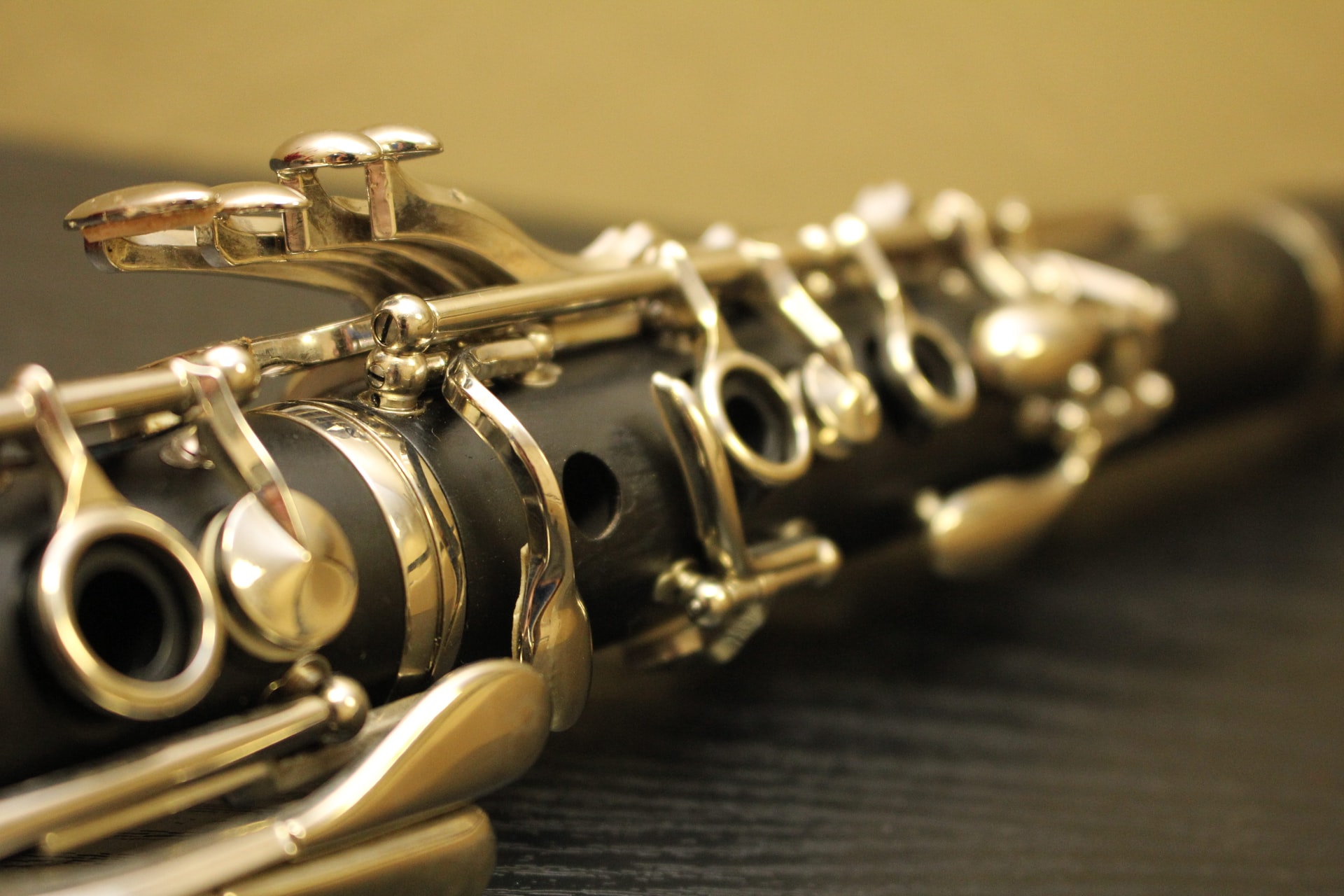
Final Thoughts
Buying a clarinet will ultimately depend on your needs and your price budget. The Mendini B Flat clarinet falls firmly into the budget student category. It is the definition of ‘you get what you pay for.’ While it’s a good clarinet for those just wanting to try the instrument out. It doesn’t have enough growth potential if you end up liking the clarinet or are serious about learning it. I recommend the Jean Paul CL 350 or Prelude Clarinet by Conn Selmer for those who can spend a bit more. These clarinets are from trust brands and are made with quality materials. They won’t disappoint you.
Looking for more interesting readings? Check Out:

